|
|
|
|
 |
CARNIVORES: Mountain Lions |
|
|
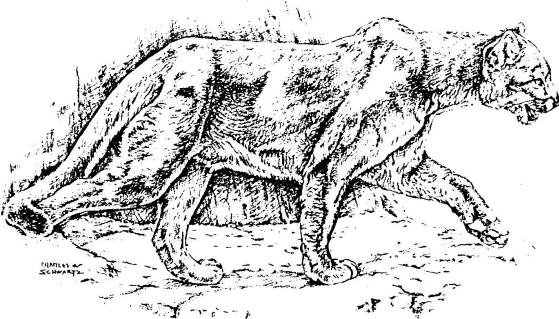
Fig. 1. Mountain lion,
Felis concolor
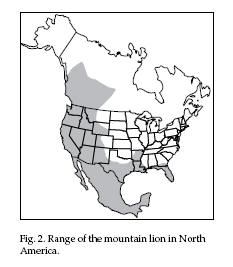 Identification Identification
The mountain lion (cougar, puma, catamount, panther;
Fig. 1) is the largest cat native to North America. The
head is relatively small, and the face is short and
rounded. The neck and body are elongate and narrow. The
legs are very muscular and the hind legs are
considerably longer than the forelegs. The tail is long,
cylindrical, and well-haired. The pelage of the mountain
lion varies considerably. There are two major color
phases — red and gray. The red phase varies from buff,
cinnamon, and tawny to a very reddish color, while the
gray phase varies from silvery gray to bluish and slate
gray. The sides of the muzzle are black. The upper lip,
chin, and throat are whitish. The tail is the same color
as the body, except for the tip, which is dark brown or
black. The young are yellowish brown with irregular rows
of black spots. Male mountain lions are usually
considerably larger than females. Adults range from 72
to 90 inches (183 to 229 cm) in total length including
the tail, which is 30 to 36 inches (76 to 91 cm) long.
They weigh from 80 to 200 pounds (36 to 91 kg). The
mountain lion’s skull has 30 teeth. Female mountain
lions have 8 mammae.
Range
The range of the mountain lion in North America is shown
in figure 2. Its primary range occurs in western Canada
and in the western and southwestern United States.
Sparse populations occur in the south, from Texas to
Florida. Several mountain lion sightings have occurred
in midwestern and eastern states but populations are not
recognized.
Habitat
The mountain lion can be found in a variety of habitats
including coniferous forests, wooded swamps, tropical
forests, open grasslands, chaparral, brushlands, and
desert edges. They apparently prefer rough, rocky,
semiopen areas, but show no particular preferences for
vegetation types. In general, mountain lion habitat
corresponds with situations where deer occur in large,
rugged, and remote areas.
Food
Habits
Mountain lions are carnivorous. Their diet varies
according to habitat, season, and geographical region.
Although deer are their preferred prey and are a primary
component of their diet, other prey will be taken when
deer are unavailable. Other prey range from mice to
moose, including rabbits, hares, beaver, porcupines,
skunks, martens, coyotes, peccaries, bear cubs,
pronghorn, Rocky Mountain goats, mountain sheep, elk,
grouse, wild turkeys, fish, occasionally domestic
livestock and pets, and even insects. Mountain lions,
like bobcats and lynx, are sometimes cannibalistic.
General
Biology, Reproduction, and Behavior
Mountain lions are
shy, elusive, and primarily nocturnal animals that
occasionally are active during daylight hours. For this
reason they are seldom observed, which leads the general
public to believe that they are relatively rare, even in
areas where lion populations are high. They attain great
running speeds for short distances and are agile tree
climbers. Generally solitary, they defend territories.
Dominant males commonly kill other males, females, and
cubs. A mountain lion’s home range is usually 12 to 22
square miles (31 to 57 k2), although it may travel 75 to
100 miles (120 to 161 km) from its place of birth.
The
mountain lion does not have a definite breeding season,
and mating may take place at any time. In North America
there are records of births in every month, although the
majority of births occur in late winter and early
spring. The female is in estrus for approximately 9
days. After a gestation period of 90 to 96 days, 1 to 5
young (usually 3 or 4) are born. The kittens can eat
meat at 6 weeks although they usually nurse until about
3 months of age. The young usually hunt with their
mother through their first winter.
Historically,
the North American mountain lion population was
drastically reduced by the encroachment of civilization
and habitat destruction. Some populations in the West
are growing rapidly. Local populations may fluctuate in
response to changes in prey populations, particularly
deer, their primary food source.
The
mountain lion is usually hunted as a trophy animal with
the aid of trail and sight hounds. Pelts are used for
trophy mounts and rugs; claws and teeth are used for
jewelry and novelty ornaments. The mountain lion is not
an important species in the fur trade. In North America,
it is primarily harvested in Arizona, New Mexico, Utah,
Colorado, Idaho, western Montana, British Columbia, and
Alberta.
Damage
and Damage Identification
Mountain lions are predators
on sheep, goats, cattle, and horses. House cats, dogs,
pigs, and poultry are also prey. Damage is often random
and unpredictable, but when it occurs, it can consist of
large numbers of livestock killed in short periods of
time. Cattle, horse, and burro losses are often chronic
in areas of high lion populations. Lions are considered
to have negative impacts on several bighorn sheep herds
in New Mexico, Arizona, Nevada, and Colorado.
In
areas of low deer numbers, mountain lions may kill deer
faster than deer can reproduce, thus inhibiting deer
population growth. This usually occurs only in
situations where alternative prey keep lions in the area
and higher deer populations are not close by.
Lions
are opportunistic feeders on larger prey, including
adult elk and cattle. Individual lions may remain with a
herd and prey on it consistently for many weeks, causing
significant number reductions. Mountain lions cause
about 20% of the total livestock predation losses in
western states annually. Historically, lion damage was
suffered by relatively few livestock producers who
operate in areas of excellent lion habitat and high lion
populations. This historic pattern has changed in recent
years, as lion distribution has spread, resulting in
frequent sightings and occasional damage in residential
developments adjacent to rangelands, montane forests,
and other mountain lion habitat. Predation typically is
difficult to manage although removal of the offending
animals is possible if fresh kills can be located.
Sheep,
goats, calves, and deer are typically killed by a bite
to the top of the neck or head. Broken necks are common.
Occasionally, mountain lions will bite the throat and
leave marks similar to those of coyotes. The upper
canine teeth of a mountain lion, however, are farther
apart and considerably larger than a coyote’s (1 1/2
to 2 1/4 inches [3.8 to 5.7 cm] versus 1 1/8 to 1 3/8
inches [2.8 to 3.5 cm]). Claw marks are often evident on
the carcass. Mountain lions tend to cover their kills
with soil, leaves, grass, and other debris. Long scratch
marks (more than 3 feet [1 m]) often emanate from a kill
site. Occasionally, mountain lions drag their prey to
cover before feeding, leaving well-defined drag marks.
Tracks
of the mountain lion are generally hard to observe
except in snow or on sandy ground. The tracks are
relatively round, and are about 4 inches (10 cm) across.
The three-lobed heel pad is very distinctive and
separates the track from large dog or coyote tracks.
Claw marks will seldom show in the lion track. Heel pad
width ranges from 2 to 3 inches (5 to 8 cm). The tracks
of the front foot are slightly larger than those of the
hind foot. The four toes are somewhat teardrop shaped
and the rear pad has three lobes on the posterior end.
Although
uncommon, mountain lion attacks on humans occasionally
occur. Fifty-three unprovoked mountain attacks on humans
were documented in the US and Canada from 1890 to 1990.
Nine attacks resulted in 10 human deaths. Most victims
(64%) were children who were either alone or in groups
of other children. Attacks on humans have increased
markedly in the last two decades (see Beier 1991).
Legal
Status
All of the western states except California allow
the harvest of lions. They are protected in all other
states where present. Generally, western states manage
mountain lions very conservatively as big game animals.
Lion harvests are severely restricted by the harvest
methods allowed and by quotas.
If
mountain lion predation is suspected in states where
lions are protected, contact a local wildlife management
office for assistance. Most states allow for the
protection of livestock from predators by landowners or
their agents when damage occurs or is expected. Some
states, however, require that a special permit for the
control of mountain lions be obtained or that the
wildlife agency personnel or their agent do the control
work. Several states have a damage claim system that
allows for recovery of the value of livestock lost to
mountain lion predation.
Damage
Prevention and Control Methods
Exclusion
Heavy
woven-wire fencing at least 10 feet (3 m) high is
required to discourage lions. Overhead fencing is also
necessary for permanent and predictable protection.
Fencing is practical only for high-value livestock and
poultry. Night fencing under lights or in sealed
buildings is useful where practical.
Electric
fencing with alternating hot and ground wires can
effectively exclude mountain lions. Wires should be 10
feet (3 m) high, spaced 4 inches (10 cm) apart, and
charged with at least 5,000 volts.
Cultural
Methods Mountain lions prefer to hunt and stay where
escape cover is close by. Removal of brush and trees
within 1/4 mile (0.4 km) of buildings and livestock
concentrations may result in reduced predation.
Chronic
mountain lion predation has led to some ranchers
shifting from sheep to cattle production. In areas with
high levels of predation, some ranchers have changed
from cow-calf to steer operations.
Frightening
Bright lights, flashing white lights, blaring music,
barking dogs, and changes in the placement of scarecrow
objects in livestock depredation areas may temporarily
repel mountain lions. The Electronic Guard, a strobe
light/ siren device developed by USDA-APHIS-ADC, may
also deter lions.
Repellents
No chemical repellents are registered for mountain
lions.
Toxicants
No chemical toxicants are registered for mountain lion
control. Since lions prefer to eat their own kills and
fresh untainted meats, an efficient delivery system for
toxicants has not been developed.
Fig.
3. Bedded trap
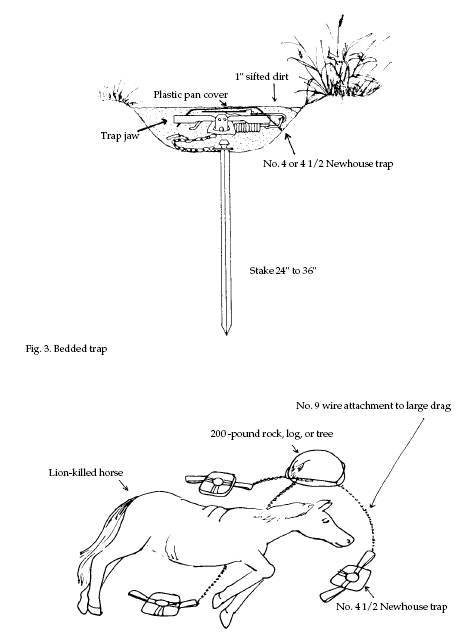 Fumigants
No chemical fumigants are registered for use on lions. Fumigants
No chemical fumigants are registered for use on lions.
Trapping
Leghold Traps. Mountain lions are extremely strong and
require very strong traps. Well-bedded Newhouse traps in
size No. 4 or 4 1/2 are recommended (Fig 3). Recommended
sets are shown in figures 3 and 4. Use large heavy
drags, sturdy stakes, or substantial trees, posts, or
rocks to anchor traps to ensure against escape.
Mountain
lions are easily trapped along habitual travel ways, in
areas of depredations, and at kill sites. Although blind
sets are usually made in narrow paths frequented by
lions, baits made of fish products, poultry, porcupine,
rabbits, or deer parts, as well as curiosity lures like
catnip, oil of rhodium, and house cat urine and gland
materials are effective attractants. Mountain lions are
very curious and respond to hanging and moving flags of
skin, feathers, or bright objects.
Leg
Snares. Leg snares are effective when set as described
in the Black Bears chapter, and as shown here in figures
4, 5, and 6. Substitute leg snares for the No. 4 or 4
1/2 leghold traps. The Aldrich-type foot snare can be
used to catch mountain lions. This set is made on trails
frequented by lions; stones or sticks are used to direct
foot placement over the triggering device.
Snares.
Snares can be set to kill mountain lions or hold them
alive for tranquilization. Commercially made mountain
lion snares are available from Gregerson Manufacturing
(see Supplies and Materials). They should be suspended
in lion runways and trails (Fig. 7), or set with baits
in cubby arrangements (Figs. 8 and 9).
Kill
snares should be placed with the bottom of the loop
approximately 16 inches (40 cm) above the ground with a
loop diameter of 12 to 16 inches (30 to 41 cm). Snares
intended to capture lions alive should be placed with
the bottom of the loop 14 inches (36 cm) from the ground
and a loop diameter of 18 to 20 inches (46 to 51 cm).
Snares set for live capture should be checked daily from
a distance.
Cage
Traps. Large, portable cage traps are used by
USDA-APHIS-ADC personnel in California to capture
moutain lions that kill pets and livestock in suburban
areas and on small rural holdings. The traps are
constructed of 4-foot (120-cm) wide, 4-foot (120-cm)
high, 10-foot (3-m) long welded-wire stock panels with 2
x 4-inch (5 x 10-cm) grid. The trap is placed where the
mountain lion left the kill, and it is baited with the
remains of the kill. See Shuler (1992) for details on
this method.
Shooting
Mountain lions sometimes return to a fresh kill to feed
and can be shot from ambush when they do so. Locate an
ambush site where the shooter cannot be seen and the
wind carries the shooter’s odor away from the
direction that the cat will use to approach the kill
site. Set up at least 50 yards (45 m) from the kill
site. Calibers from .222 Remington and larger are
recommended. Mountain lions can be called into shooting
range with predator calls, particularly sounds that
simulate the distress cry of a doe deer. See Blair
(1981) for additional information on calling lions.
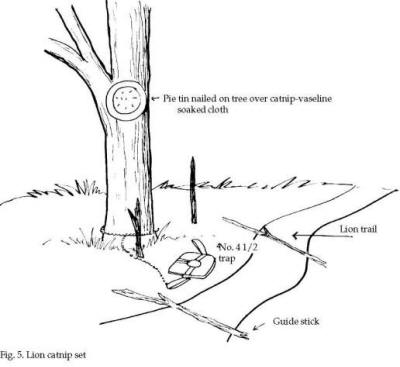
Other
Methods Trained dogs can be used to capture or kill
depredating lions. The dogs are most often released at
the kill site, where they pick up the lion’s scent and
track the lion until it is cornered or climbs a tree.
The lion can then be shot and removed, or tranquilized
and transplanted at least 300 miles (480 km) away.
Transplanting of lions is not recommended unless they
are moved to an area where no present lion population
exists, where habitat and weather are similar to those
of the original area, and where there will be no problem
of potential depredation by the translocated lions.
Placing a mountain lion in an area with which it is
unfamiliar reduces its chance of survival and is likely
to disrupt the social hierarchy that exists there. Lions
from a distant area may transmit a disease or
contaminate a gene pool that has been maintained through
a natural selection process for population survival in a
specific area. In addition, depredating lions are likely
to cause depredation problems in the area to which they
are transplanted.
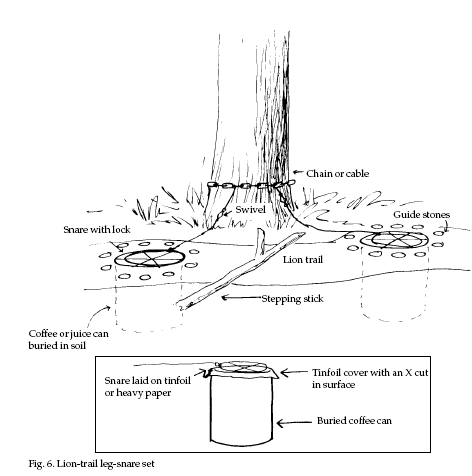 Hunting
of mountain lions as big game animals should be
encouraged in areas of predation to lower the
competition for native food sources. To reduce or
eliminate future losses, quick action should be taken as
soon as predation is discovered. Hunting
of mountain lions as big game animals should be
encouraged in areas of predation to lower the
competition for native food sources. To reduce or
eliminate future losses, quick action should be taken as
soon as predation is discovered.
Economics
of Damage and Control Verifying livestock losses to
mountain lions is difficult because of the rough
mountainous terrain and vegetation cover present where
most lion predation occurs. Many losses occur that are
never confirmed. Generally, lion predation is
responsible for only a small fraction of total predation
losses suffered by ranchers, but individual ranchers may
suffer serious losses.
In
Nevada, it was estimated that annual losses of range
sheep to mountain lions averaged only 0.29% (Shuminski
1982). These losses, however, were not evenly
distributed among ranchers. Fifty-nine sheep (mostly
lambs) were killed in one incidence. The mountain lion
involved apparently killed 112 sheep in the area before
it was captured.
In
states such as Colorado and Wyoming, where damages are
paid for lion predation, contact the state wildlife
agency for information about the claims process and
paperwork. Most systems require immediate reporting and
verification of losses before payments are made.
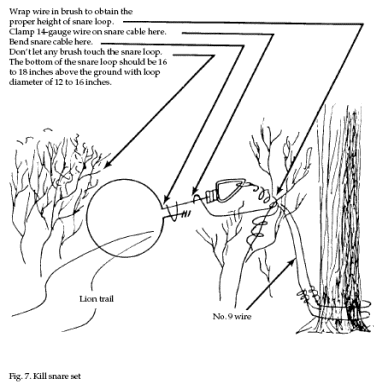 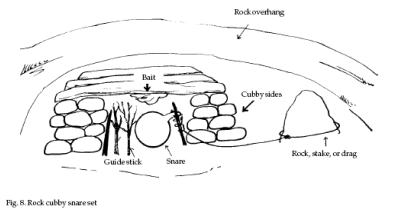 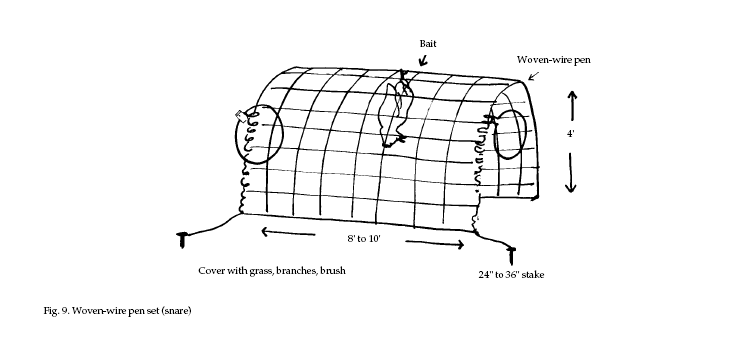
Acknowledgments
Much of this information was prepared by M. L. Boddicker
in “Mountain Lions,” Prevention and Control of
Wildlife Damage (1983).
I
thank Keith Gregerson for use of the snare suspension
and anchoring diagram and the Colorado Trapper’s
Association for use of diagrams of lion sets from its
book (Boddicker 1980). Sections on identification,
habitat, food habits, and general biology are adapted
from Deems and Pursley (1983).
Figures
1 and 2 from Schwartz and Schwartz (1981), adapted by
Jill Sack Johnson.
Figures
3, 4, 5, and 6 from Boddicker (1980).
Figure
7 courtesy of Gregerson Manufacturing Co., adapted by
Jill Sack Johnson.
Figures
8 and 9 by Boddicker, adapted by Jill Sack Johnson.
For
Additional Information
Beier, P. 1991. Cougar attacks on
humans in the United States and Canada. Wildl. Soc.
Bull. 19:403-412.
Blair,
G. 1981. Predator caller’s companion. Winchester
Press, Tulsa, Oklahoma. 267 pp.
Boddicker,
M. L., ed. 1980. Managing rocky mountain furbearers.
Colorado Trappers Assoc., LaPorte, Colorado. 176 pp.
Bowns,
J. E. 1985. Predation-depredation. Pages 204-205 in J.
Roberson and F. G. Lindzey, eds. Proc. Mountain Lion
Workshop, Salt Lake City, Utah.
Deems,
E. F. and D. Pursley, eds. 1983. North American
furbearers: a contemporary reference. Int. Assoc. Fish
Wildl. Agencies and the Maryland Dep. Nat. Resour.,
Annapolis. 223 pp.
Hornocker,
M. G. 1970. An analysis of mountain lion predation upon
mule deer and elk in the Idaho primitive area. Wildl.
Monogr. 21. 39 pp.
Hornocker,
M. G. 1976. Biology and life history. Pages 38-91 in G.
C. Christensen and R. J. Fischer, eds. Trans. mountain
lion workshop, Sparks, Nevada.
Lindzey,
F. G. 1987. Mountain lion. Pages 657668 in M. Novak, J.
A. Baker, M. E. Obbard, and B. Malloch. Wild furbearer
management and conservation in North America. Minist.
Nat. Resour., Toronto, Ontario.
Paradiso,
J. L. 1972. Status report on cats (Felidae) of the
world, 1971. US Fish Wildl. Serv., Special Sci. Rep.,
Wildl. No. 157. 43 pp.
Robinette,
W. L., J. S. Gashwiler, and O. W. Morris. 1959. Food
habits of the cougar in Utah and Nevada. J. Wildl.
Manage. 23:261-273.
Schwartz,
C. W. and E. R. Schwartz. 1981. The wild mammals of
Missouri. rev. ed. Univ. Missouri Press, Columbia. 356
pp.
Sealander,
J. A., and P. S. Gipson. 1973. Status of the mountain
lion in Arkansas, Proc. Arkansas Acad. Sci. 27:38-41.
Sealander,
J. A., M. G. Hornocker, W. V. Wiles, and J. P. Messick.
1973. Mountain lion social organization in the Idaho
primitive area. Wildl. Mono. 35:1-60.
Shaw,
H. 1976. Depredation. Pages 145-176 in G. C. Christensen
and R. J. Fischer, eds. Trans. mountain lion workshop,
Sparks, Nevada.
Shuler,
J. D. 1992. A cage trap for live-trapping mountain
lions. Proc. Vertebr. Pest Conf. 15:368-370.
Shuminski,
H. R. 1982. Mountain lion predation on domestic
livestock in Nevada. Proc. Vertebr. Pest Conf. 10:62-66.
Editors
Scott E. Hygnstrom; Robert M. Timm; Gary E. Larson
PREVENTION
AND CONTROL OF WILDLIFE DAMAGE — 1994
Cooperative
Extension Division Institute of Agriculture and Natural
Resources University of Nebraska -Lincoln
United
States Department of Agriculture Animal and Plant Health
Inspection Service Animal Damage Control
Great
Plains Agricultural Council Wildlife Committee
01/23/2007
Special
thanks to:
Clemson University
|